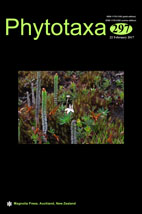Abstract
Eurycorymbus is an unusual monotypic genus of Sapindaceae endemic to China. The floral organogenesis of E. cavaleriei has been investigated with the light and scanning electron microscope to clarify its floral characters and its uncertain systematic position. Eurycorymbus cavaleriei possesses several unique characteristics in Sapindaceae. Flowers are unisexual. Sepals initiate in a spiral sequence, followed by five alternating petals which resemble sepals at maturity. The sequential initiation of eight stamens partly overlaps with that of the petals. Three carpellary lobes are simultaneously demarcated and merge gradually to form a tricarpellate ovary. Mature stamens of male flowers have long and smooth filaments, which are folded in buds. In female flowers only one or two ovules per ovary develop into seeds. The extrastaminal nectary forms doubly scalloped lobes. Symmetry changes from oblique monosymmetry at a mid-developmental stage to polysymmetry at maturity. It is suggested that monosymmetry might precede polysymmetry in the evolution of Sapindaceae.

